This is a Kodak Motormatic 35 camera. It is an updated version of Kodak’s first 35mm auto exposure camera, the Kodak Automatic 35 which was released the year before. The Motormatic added a spring motor advance, allowing a photographer to make exposures as fast as he or she could press the shutter release. The Automatic and Motormatic series were historically significant as Kodak’s last line of cameras built in the United States. All cameras to feature the Kodak name in years to come were manufactured overseas by someone else and sold as Kodaks. All models in the Automatic/Motormatic series have a very good 4-element Kodak Ektanar f/2.8 lens which allowed them to make fantastic photos.
Film Type: 135 (35mm)
Lens: 44mm f/2.8 Kodak Ektanar coated 4-elements
Focus: 3 feet to Infinity with Click Stops for Close-Ups, Groups, and Scenes
Viewfinder: Scale Focus with 44mm Projected Frame Lines, Zone Focus Minder, and Low Light Indicator
Shutter: Kodak Automatic Flash Leaf Shutter
Speeds: 1/40 – 1/250 seconds
Exposure Meter: Coupled Selenium Cell w/ front plate readout and Programmed AE
Battery: None
Flash Mount: Side Mounted Kodalite Flash with M and X Flash Sync
Weight: 731 grams
Manual: http://www.cameramanuals.org/kodak_pdf/kodak_motormatic_35.pdf
History
Kodak has a rich history which I’ve covered before in several other posts that you can read about here, here, and here if you’re interested. But for this review, I’ll focus on Kodak’s post war 35mm offerings.
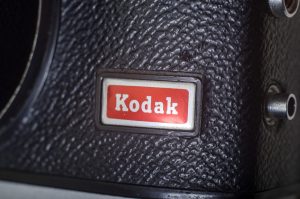 The Eastman-Kodak Company has always been a film-first company. With only a few exceptions, the majority of Kodak’s camera offerings have been modest in nature and designed primarily to keep customers coming back for more film. While many collectors have a distaste for Kodak’s proprietary 620 format as it was simply 120 film rolled onto smaller spools, it’s worth noting that 620 wasn’t the company’s only attempt at film created to serve their own purposes.
The Eastman-Kodak Company has always been a film-first company. With only a few exceptions, the majority of Kodak’s camera offerings have been modest in nature and designed primarily to keep customers coming back for more film. While many collectors have a distaste for Kodak’s proprietary 620 format as it was simply 120 film rolled onto smaller spools, it’s worth noting that 620 wasn’t the company’s only attempt at film created to serve their own purposes.
Nearly every roll film format that ever existed, was at one point created by Kodak for a Kodak specific camera. Type 105 was created for the Folding Pocket Kodak in 1898, 117 for the first Kodak Brownie in 1900, 120 for the No. 2 Brownie in 1901, 127 for the Vest Pocket Kodak in 1912, and so on. You could even say that Kodak’s type 135 format of 35mm film was first created for the Kodak Retina in 1934. In each of these instances, a new format of film was introduced with a new Kodak camera so that people had a reason to buy these films. This practice would continue throughout the remainder of the 20th century, including type 126 “Instamatic” film in 1963, type 110 “Pocket Instamatic” film in 1972, and finally, APS “Advantix” film in 1996.
Being a film first company that also on occasion made cameras, it’s no surprise that, sometimes Kodak made a good camera. With the resources the company likely had in the mid 20th century, I have to believe there were those on the company’s payroll who actually had an interest in making some good cameras. I have no evidence of this, but I have to imagine that these design departments who were in charge of creating new models, likely weren’t given the resources or support from upper management to create the cameras that they really wanted. This is the only explanation I can come up with the seemingly random release of new models that Kodak produced starting in the late 1940s through the 1960s. Kodak would release two models back to back, one of which had an elegant design with a good lens, but the other with a bizarre arrangement of features and questionable quality control. Sometimes a new model would replace an older model, but lack a feature the original had.
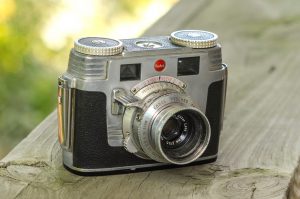
Kodak’s Signet line is the one that proves this point the most, with some models like the Kodak Signet 35 having an elegant and clean all metal design, but then immediately followed up by curious looking models like the Signets 40 and 50. There seemed to be no rhyme or reason for the numbering systems. The Signets 35, 40, and 80 all were rangefinders, Signet 30 and 50 were scale focus cameras, 50 and 80 had meters, and the 80 had interchangeable lenses. Further complicating the series is that while the Signets 30 and 50 somewhat resemble each other, each of the other models look nothing alike.
Whatever the reason for the huge disparity in design and features of the Signet series, by 1959, a new era was dawning in compact 35mm cameras, which was automatic exposure. The year 1959 coincidentally saw the release of a huge number of new models by companies are varied as Kodak, Bell & Howell, Brawn, Revere, Fujica, and others all capable of some variety of AE.
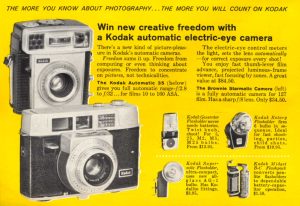
Many of these early AE cameras were rudimentary designs with a single shutter speed and very limited lenses. Many of these cameras were scale focus only and offered no manual control of any kind. In an effort to not be predictable, in 1959 Kodak would eschew this simple formula and release what was called the Kodak Automatic 35. Compared to the rest of the AE class of 1959, the Kodak Automatic 35 was not only a good looking camera, but was pretty high class. The camera boasted a large and bright viewfinder with projected frame lines, an excellent 4-element 44mm f/2.8 Kodak Ektanar lens, full flash synchronization, and full manual control of the camera’s 4-speed shutter. Certainly not a pro camera, but it was quite a step up from it’s competition.
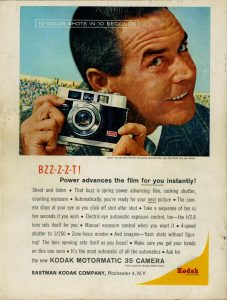
It is said that the Kodak Automatic 35 was based off the body of the Signet 50, but I’m really not sure if that’s true. Sure, the two models share bodies that are approximately the same size, and both have a front mounted shutter release, and a similar flash connector, but otherwise, the two cameras look nothing alike.
The Kodak Automatic 35 was very successful for Kodak and was in production for a decade, before being discontinued in 1969. Along the way, the model saw a few revisions and in 1960, one somewhat major variant called the Kodak Motormatic 35.
The Motormatic 35 was essentially an Automatic 35 with an identical feature set, but one new feature which was the spring wound automatic film transport. Instead of a bottom mounted wind lever like on the Automatic series, the Motormatic featured a large clockwork knob that when wound up, would maintain constant pressure on the film transport, allowing the camera to automatically advance the film and cock the shutter after each exposure was made. This new spring wind cocking system allowed a photographer to fire off shots at slightly faster than one frame per second, which for the time was blistering fast.
When fully wound, the clockwork “motor” allows for 9 to 10 exposures before needing to be wound again. It’s worth mentioning that you’ll need to keep winding it more than once throughout a whole roll of film, but the idea was that by winding up the camera before needing it, you were free to fire off several frames of film in rapid succession to photograph hard to capture subjects. Take a look at this 1960 commercial for the Kodak Motormatic featuring Ozzie Nelson from the Ozzie and Harriet show:
https://www.youtube.com/watch?v=CHDX2sD9J0o
The Motormatic 35 was sold alongside the Automatic 35 for $109.50 which was $25 higher than the Automatic. When adjusted for inflation, that compares to about $924 today making it quite an investment for the typical American family. I am sure potential buyers were intrigued at the thought of fast action shots, I have to wonder how many people were willing to pay a near 30% premium over the cost of the Automatic just for this one feature. I was never able to find any production numbers for this model, but it couldn’t have been too low as the Motormatic continued to be offered alongside the Automatic into the series’s discontinuation in 1969.
Like the Automatic 35, the Motormatic 35 saw the release of two updated models, the 35F in 1962 and the 35R4 in 1965. The basic layout of the camera, lens, and shutter remained the same with the most obvious change being in flash compatibility. The earlier 35F model adds support for an AG-1 flash bulb under a door on the top plate of the camera, and the 35R4 replaced that with a Flashcube port. Less obvious though was that both the 35F and 35R4 models removed the manual aperture setting for the camera, meaning that these models could only be used in full automatic AE mode. This likely wasn’t a big loss back in the 1960s when the typical “family snapshooter” likely wouldn’t have ever used the manual mode, but it becomes more of an issue with collectors today because without a working meter, there is no way to manually control the iris.
Today, the Kodak Automatic and Motormatic series remain an under-the-radar model from Kodak. Like many of their Signet series, these solidly built cameras with better than average 4-element lenses are better than most people give them credit for. The Kodak Ektanar lenses never gained the reputation of other 4-element designs like the Zeiss Tessar, but that doesn’t mean they weren’t nearly as capable (I hesitate to say they’re equal as I’m sure someone will contact me and accuse me of heresy).
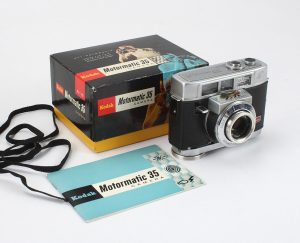
Sadly, these cameras were the last American made 35mm Kodak cameras. Kodak would actually exit the 35mm camera making business for a while before returning with some compact point and shoots in the 1980s, but these were all rebadged models made for Kodak by some other company. I started out this article saying that Kodak always was a “film first” company and it appeared that by the late 1960s, the company decided to fully commit to that mentality as they thought it wise to stop producing their own products.
Repairs
Thankfully, this Kodak Motormatic 35 came to me in excellent working order and needed no repairs, but in the event you are not as lucky as I am and yours needs some help, I was able to find examples of both the Service and Parts Manuals for this camera which you can download from the links below:
Kodak Motormatic 35 Service Manual
Kodak Motormatic 35 Parts List
My Thoughts
Kodak was a very strange company, especially in the 1950s. When I first started collecting, I bought into the “only good Kodak is a Retina” idea that a lot of people have. While I’ll agree that most Retinas are well built cameras capable of outstanding photographs, I have quickly learned that if you immediately discount all non-Retinas you’re doing yourself a disservice.

My first “a-ha” moment came when I ran my first roll of film through the original Kodak 35. A rather ordinary early 35mm camera, it had a large flip up viewfinder with no focus aide, a rudimentary film transport that uses the film sprockets to cock the shutter, and a crude implementation of a shutter release on the side of the camera.
Yet, once I took the camera shooting, I found it’s basic feature set to be empowering, rather than limiting. The 4-element Anastigmat Special lens had a rather wide depth of field, especially outdoors, and the large flip up viewfinder meant I could easily compose my shots quickly and without squinting. The position of the shutter release whcih seemed like was poorly implemented, turned out to be in a very natural location for my right index finger when it came time to make a photograph. I found myself shooting through the roll a lot faster than I had with other cameras, and when it came time to get the images developed, I was amazed at the results.
I didn’t know this at the time, but Kodak’s 4-element lenses are based off a Tessar design and when equipped with their later Lumenized coating (that original Kodak 35 didn’t have the coating), was capable of sharp and vivid photographs every bit as good as those produced with more well known German lenses. The Kodak 35 turned out to be an early favorite of mine, and one that I frequently would mention in online polls of “most underrated camera”.
It would seem that the idea that the only good Kodak was a Retina wasn’t as true as I had heard. I started to explore other 35mm Kodak cameras. There was the Signet 35, the Signet 80, and even the Instamatic 700 and 800 series, all of which had some of Kodak’s best glass that the company had to offer. Sure, the designs of each of these cameras ranges from “hmm, that’s neat” to “what were they thinking”, but once you get past the charm of their quirky designs, you were left with a camera that was quite capable and definitely underappreciated by collectors.
So when it came time to try out the Kodak Motormatic 35, I had high hopes. Unlike many other non German Kodaks, the Motormatic 35 (and it’s nearly identical twin Automatic 35) are quite handsome cameras. The body is neither too big, nor too small. The main part of the body is made entirely Bakelite and has a pebbled synthetic body covering that has a nice amount of grippiness without being sticky. The top and bottom plates of the camera are elegant pieces of stamped metal and have an excellent fit and finish adding to the overall quality feel of the camera.
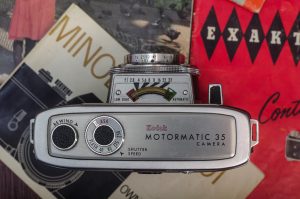
The top plate features from left to right, the rewind knob, dual film speed and shutter speed knob, and a large open space for the prominent Kodak Motormatic 35 logo. The two later variants of the Motormatic called the 35F and 35R4 have built in flash sockets in this location.
In front of the top plate is the meter readout for the camera’s built in selenium exposure meter. There is both a black needle and a green pointer behind the curved window. The black needle indicates an appropriate f/stop that the camera will choose based on available light, and the green pointer indicates whether the camera is set to Automatic mode, or if you’ve manually selected an f/stop. All Automatic/Motormatic models are designed to work in shutter priority auto exposure mode, but only the original Automatic 35 and Motormatic 35 models have the option to override the aperture setting, which is useful if your example has a dead meter. This is really important when searching for one of these cameras because if you get a later variant called the 35B, 35F, or 35R4, you will not have the ability to manually control the aperture and will be entirely dependent on the meter. Thankfully the meter on my example was still working, so I had the luxury of shooting the camera in both Auto and Manual modes.
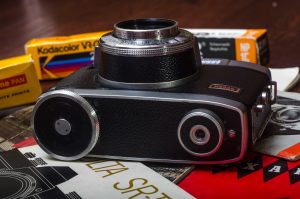
The bottom of the camera is where the large knob for winding the camera resides. Compared to the non-Motormatic models, this is the only area in which the two cameras differ. Instead of a traditional wind lever, the knob is wound up to put tension on the camera’s built in “motor”. Opposite this knob is a raised platform for the tripod socket.
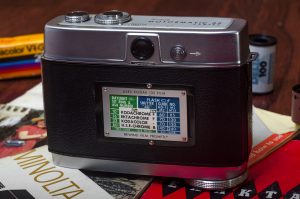
The back of the film door features a handy flash guide reminder card that can be changed out for what I assume was a variety of different film types. My example had this one card in place, so I am not sure what other cards (if any) were available to go here.
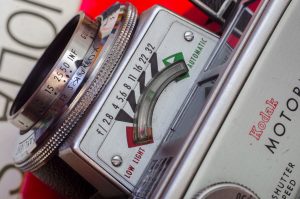
Above the reminder card, is the viewfinder, the setting wheel for the aperture, and a sliding lock to set the camera in Manual mode. The presence of the aperture control immediately below the viewfinder is is a strange location to find something like this, and it’s not marked in anyway to know what it does for those without access to the user’s manual (or this review).
Turning this wheel moves the green pointer I previously mentioned in the meter readout above the lens. When turned all the way to the right, the camera is in Automatic mode and will automatically select an appropriate f/stop based on available light, shutter speed, and film speed. If you would like to manually control the aperture, slide the lock to the right of the viewfinder to the right while simultaneously rotating the aperture wheel to the left. This will move the green pointer to a manually selected f/stop of your choosing. There is a position in the meter readout that says “Low Light” which will prevent the shutter from firing when the camera is in Automatic mode, but will allow for underexposed shots when set to manual mode.
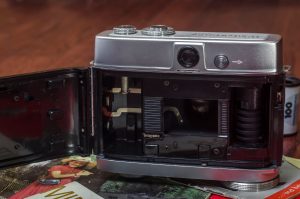
Loading film into the camera requires releasing the door lock on the camera’s right side. This will pop open the film compartment door which is hinged on the camera’s left side. Film loads into the camera from left to right. The take up spool is tensioned by the wind knob on the bottom of the camera and without film in the camera, will freely rotate. It can be a little tricky to load film into this camera the first time you do it as you must be sure that the film leader is properly attached to the hook on the take up spool before closing the camera.
After closing the camera, you must turn the wind knob on the bottom of the camera to properly set the camera for the first exposure. The camera will automatically pull the film leader a full two frames before setting it on the first exposure. You should feel increased tension and hear a clicking noise once the camera has reached the first exposure. The exposure counter is automatically resetting and will set itself to ‘1’ when the camera is ready for it’s first shot. If you feel as though you’ve wound the camera and it keeps winding without any tension on the knob, it is possible the film leader wasn’t properly attached to the take up spool which means you’ll have to open the camera and try again.

The viewfinder on the Motormatic is large and bright. Wearing prescription glasses, I had no problem seeing the entire frame from within the window. There are projected frame lines with parallax hash marks that match the 44mm focal length of the lens. Although this is a scale focus camera, there is a really neat feature that projects one of three words (CLOSE, GROUP, or SCENE) to indicate a chosen range of distances the lens is focused to. Kodak calls this feature the “Zone Minder” and while it still functions exactly like any other scale focus camera, it is convenient to get an idea of what distance the lens is set to without having to lower the camera from your eye. The choice of a 44mm lens on the camera was wise as this offers a wider depth of field range than a 50mm lens would have. In the Motormatic 35’s user manual, it states that in the Group setting and at f/11, anything from 5 to 40 feet will be sharply in focus. Use a smaller aperture like f/22 or f/32 and that range increases even more.
Similar to the Zone Minder feature, there is also a projected indicator that will say “MAN” to indicate the camera is set to Manual mode and that the automatic exposure system is disabled.
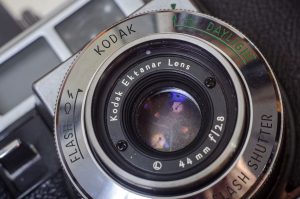
Around the lens are two rings. The outermost ring is the focus ring which rotates as you’d expect from a minimum range of 3 feet all the way to Infinity with click stops on Close, Group, and Scene, which coincide with the Zone Minder visible in the viewfinder. Around the shutter is a larger knob which is used when shooting the camera with a flash. There are two primary modes, one for Daylight, and the other for Flash. In my time with this camera, I did not play with any of the flash modes, so I won’t spend any more time talking about it, but if you’d like more information, the original user’s manual goes into greater detail on pages 20 – 23.
Next to the shutter is the shutter release which is one of the few areas in which the Motormatic resembles the earlier Signet models. The release is located comfortably where your right index finger naturally falls, so with the camera to your eye, locating it is quick and easy. Unlike other Signets however, the shutter release on the Motormatic 35 is not threaded for a shutter release cable.
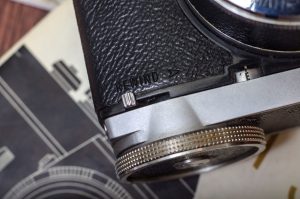
Below the shutter release is both the exposure counter and a ‘rewind release’ lever that must be activated to relieve the tension on the take up spool when you reach the last exposure on a roll. You must do this before attempting to rewind the camera otherwise the tension on the spool will prevent you from properly rewinding your exposed film back into the cassette.
As a whole, there is a lot to like about the Motormatic. I think it has a handsome design with just the right amount of plastic and metal that doesn’t make the camera cheap, but it’s also not overly heavy. The body doesn’t creak in your hands, and all of the movements of the camera are tight and secure. I love the large and bright viewfinder and implementation of the projected focus distances and Manual warning. Although lacking a rangefinder, the 44mm lens allows for a very wide depth of field making guess focus easy. The auto exposure system was pretty advanced for it’s day and I was lucky enough to find an example where the selenium meter was still working, so that should mean for some pretty quick and accurate exposure metering.
At this point, I’ve described my thoughts on the Automatic 35, but this isn’t the Automatic 35, its the Motormatic 35, and what kind of review would it be if I didn’t touch upon the camera’s signature feature. Simply, the motor wind is really neat. There’s something that appeals to me on a primal level when I hear the clockwork “click, click, click, click” while winding up the camera. Upon pressing the shutter release, the motorized movement of the camera sounds like nothing you can hear today. The sound this camera makes is unlike those of early point and shoot cameras from the late 70s and early 80s with their electric motors that sound like garage door openers on PCP. The motorized film advance of the Motormatic 35 is really, really cool! Oh heck, I should stop talking about it and let you hear it for yourself
https://youtu.be/59AlU0piy1A
My Results
As I do almost every Christmas, I went to visit family in Northern Michigan, and with me a brought a few cameras including the Motormatic. As the weather is very cold and dreary in that part of the country in late December, I loaded in some fresh Ilford Delta 400 in the hope of capturing some nice winter landscapes. Attached to the lens, I included a Series V Kodachrome Type A Daylight filter to maximize contrast. I don’t normally shoot B&W film with filters, so this was new territory for me.
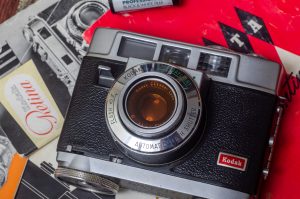
As promised, the 4-element Ektanar delivered, the nearly 60 year old exposure system delivered, the shutter delivered, in fact, the whole camera…delivered exceptional shots. Making the most of the dreary northern Michigan winter landscapes, I was rewarded with a full roll of some very nice shots.
Looking through these examples, I can’t help but wonder what this camera would be capable of with some fresh Kodak Portra or Ektar, but I have to remind myself that given the circumstances to when I was shooting it, the Ilford Delta was the right choice. I will definitely be revisiting this camera with some color film soon.
Circling back to something I touched upon earlier that there is still a persistent belief that the only good Kodak is a Retina, which simply isn’t true. Looking past their excellent medium format cameras like the Medalist, Chevron, and Monitors, Kodak made quite a number of quality 35mm cameras.
What I think turns people off from these cameras is that Kodak never aimed for the high end of the market. They never made a Leica clone, used Zeiss lenses, or brand name German or Japanese shutters. Kodak cameras from the middle of the 20th century were created to sell Kodak film, but Kodak also understood that the cameras had to be good enough to make good pictures. Kodak’s lineup in the 1950s and 60s consisted of Signets, Automatics, and Motormatics that all made good pictures, and in the case of the Motormatic 35, had an attractive body, an innovative auto exposure system, and a unique motorized film advance. That’s pretty good if you ask me!
My Final WordHow these ratings work |
The Kodak Motormatic 35 is based off the Kodak Automatic 35 and share’s its 4-element Tessar-style lens, an accurate and easy to use auto exposure system, large and bright viewfinder, and solid and attractive body. It adds a unique motorized film advance which allowed novice photographers to shoot faster than they ever had before. This earlier model is the only in the lineup which also offers manual control of the iris, meaning that if you find one with a dead meter, it can still be used. The 44mm lens makes guess focus really easy, the meter nailed exposure on every image I shot, and the Ektanar lens lived up to it’s reputation as a quality lens. I thoroughly enjoyed using the Motormatic 35 and considering these things generally sell for cheap, it’s one heck of a bargain, and one that I highly recommend! | ||||||
| Images | Handling | Features | Viewfinder | Feel & Beauty | History | Age | |
| 2 | 1 | 1 | 2 | 2 | 0 | 20% | |
| Bonus | +1 for the complete package, this camera is greater than the some of it’s parts | ||||||
| Final Score | 10.6 | ||||||
Additional Resources
http://camera-wiki.org/wiki/Kodak_Automatic_35/Motormatic_35
https://schneidan.com/2012/08/13/kodak-motormatic-35-auto-advancing-camera/
http://retinarescue.com/motormatic.html
https://mycameracabinet.wordpress.com/2011/07/16/kodak-motormatic-35/

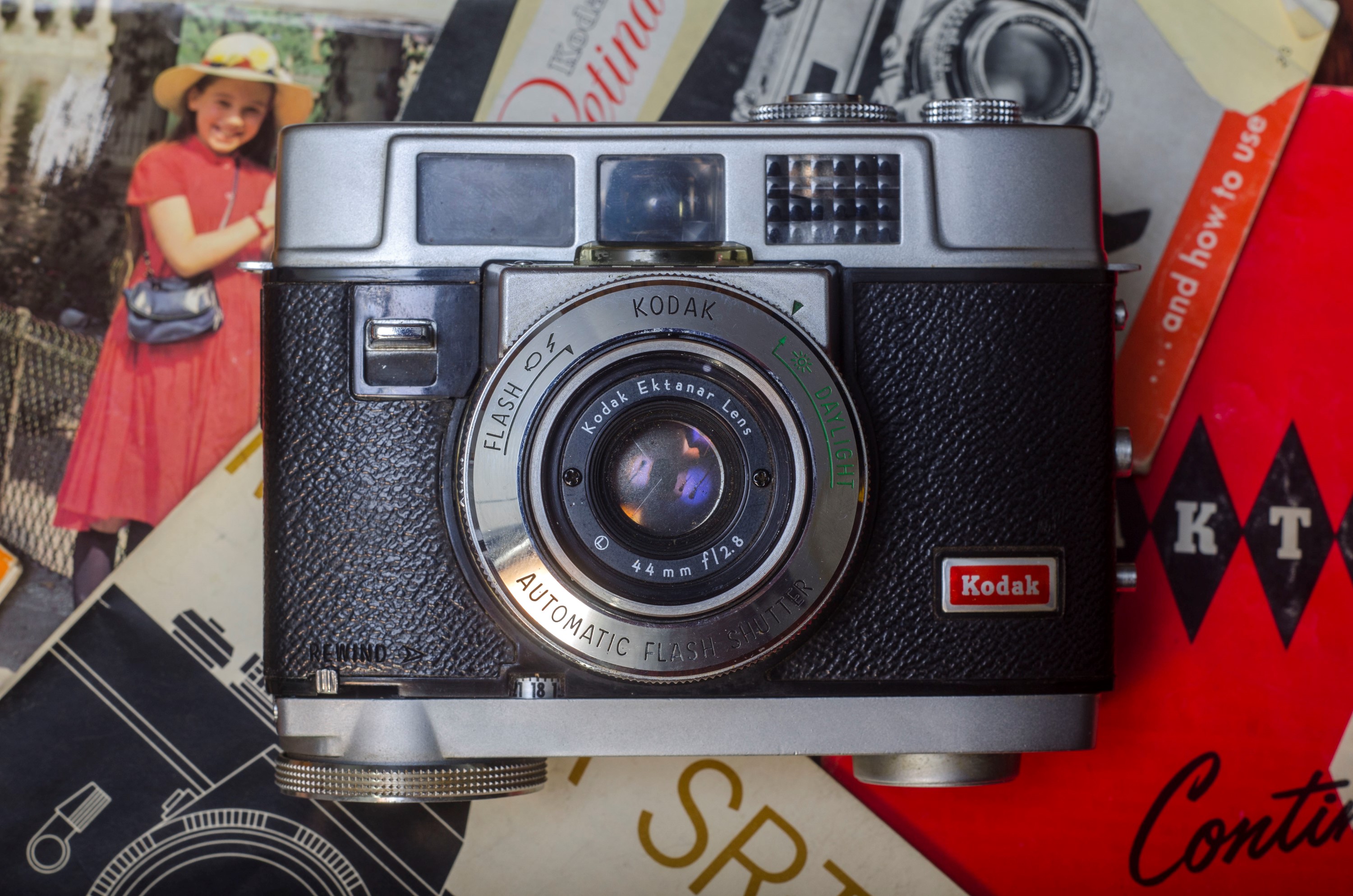











I have owned two similar Automatic 35F cameras and can attest that the lenses in these are very good.
Kodak put similar “motorized” winders in other cameras, including at least one of their Instamatic cameras.
Yes, I do believe there were some Instamatics with a motorized winder, and also ones that used a rip cord for tensioning an auto frame advance. I actually have one of the ripcord models, the X-90, but dont have any usable 126 film for it.
Very informative article as always and really nice shots Mike- I particularly like pictures 1,2 and 6.
Had one of these some years back. Built like a tank and actually worked. Mike are you coming to the Photorama show on Sunday/
I tried one of these out some years ago but mine had some type of problem with the shutter that rendered it non working. Id like to try another at some point as it was a very nice compact 35mm camera.